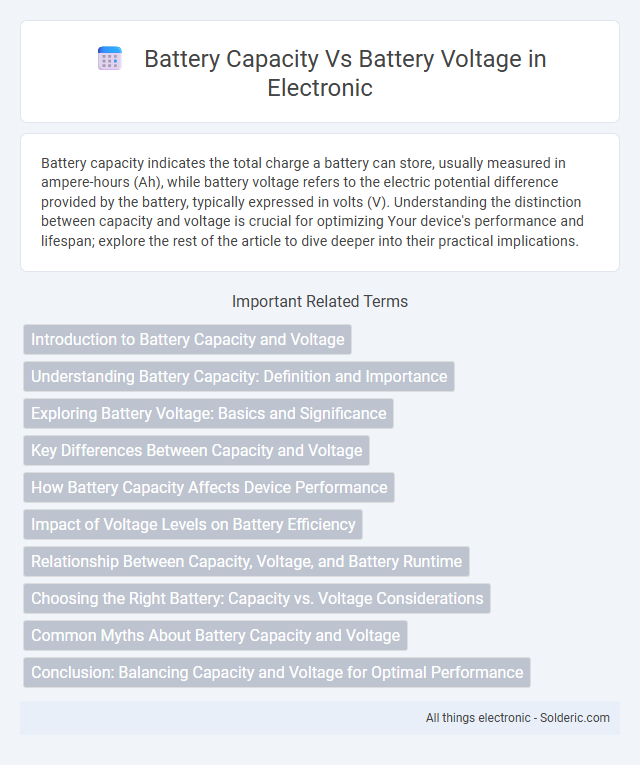Battery capacity indicates the total charge a battery can store, usually measured in ampere-hours (Ah), while battery voltage refers to the electric potential difference provided by the battery, typically expressed in volts (V). Understanding the distinction between capacity and voltage is crucial for optimizing Your device's performance and lifespan; explore the rest of the article to dive deeper into their practical implications.
Comparison Table
| Parameter | Battery Capacity | Battery Voltage |
|---|---|---|
| Definition | Amount of electric charge stored, measured in ampere-hours (Ah) or milliampere-hours (mAh) | Electric potential difference between battery terminals, measured in volts (V) |
| Unit | Ah or mAh | Volts (V) |
| Indicates | Battery runtime or energy storage capacity | Power output potential |
| Effect on Device | Determines how long the device can operate before recharging | Determines compatibility with device voltage requirements |
| Typical Values | 1000mAh to 5000mAh (common in consumer batteries) | 1.2V (NiMH), 3.7V (Li-ion), 12V (lead-acid automotive battery) |
| Relation | Higher capacity means longer usage time | Higher voltage means higher power delivery potential |
Introduction to Battery Capacity and Voltage
Battery capacity, measured in ampere-hours (Ah), indicates the total charge a battery can store and deliver over time, reflecting how long your device can operate before needing a recharge. Battery voltage, expressed in volts (V), determines the electrical potential difference that drives current through the circuit, influencing the power output and compatibility with electronic components. Understanding the relationship between capacity and voltage helps optimize battery performance and ensures efficient energy management for your applications.
Understanding Battery Capacity: Definition and Importance
Battery capacity, measured in ampere-hours (Ah) or milliampere-hours (mAh), quantifies the total charge a battery can store, directly impacting the runtime of your device. Battery voltage, expressed in volts (V), determines the power output and compatibility with electronic components but does not indicate storage capacity. Understanding these distinctions is crucial for optimizing your device's performance and selecting the right battery for your specific energy needs.
Exploring Battery Voltage: Basics and Significance
Battery voltage represents the electric potential difference between the positive and negative terminals, typically measured in volts (V), and it determines the energy supplied to a device. Battery capacity, measured in ampere-hours (Ah), indicates the total charge a battery can store and directly affects the duration a device can operate before recharging. Understanding the interplay between voltage and capacity is crucial for optimizing battery performance and ensuring compatibility with electronic equipment.
Key Differences Between Capacity and Voltage
Battery capacity, measured in ampere-hours (Ah) or milliampere-hours (mAh), indicates the total charge a battery can store and deliver over time, directly affecting the device's runtime. Battery voltage, expressed in volts (V), represents the potential difference or the electrical pressure driving current through a circuit, determining the power output and compatibility with electronic devices. While capacity impacts how long a battery lasts, voltage dictates the device's operational requirements and performance stability.
How Battery Capacity Affects Device Performance
Battery capacity, measured in milliampere-hours (mAh), directly impacts the runtime and efficiency of your device by determining how long it can operate before requiring a recharge. Higher capacity batteries provide extended usage times, allowing devices such as smartphones, laptops, and electric vehicles to function longer under consistent loads. Battery voltage influences the power output level, but capacity primarily dictates how long the energy supply sustains device performance.
Impact of Voltage Levels on Battery Efficiency
Battery capacity measured in ampere-hours (Ah) indicates the total charge a battery can store, while battery voltage reflects the electric potential difference. Higher voltage levels can enhance battery efficiency by reducing current for the same power output, minimizing energy losses due to heat and internal resistance. Understanding how voltage impacts efficiency helps you optimize battery performance for longer lifespan and better energy utilization.
Relationship Between Capacity, Voltage, and Battery Runtime
Battery capacity, measured in ampere-hours (Ah), directly influences the total energy storage of a battery, while battery voltage, measured in volts (V), determines the electrical potential delivered to a device. The total energy available is the product of capacity and voltage, expressed in watt-hours (Wh), which is crucial for estimating battery runtime. Higher voltage increases power output, but battery runtime depends on the balance between voltage and capacity, with greater capacity extending usage duration under consistent load conditions.
Choosing the Right Battery: Capacity vs. Voltage Considerations
Choosing the right battery involves balancing capacity, measured in ampere-hours (Ah), with voltage, typically rated in volts (V), to meet your device's energy demands and operational specifications. Higher capacity batteries provide longer runtimes but may have lower voltage, which affects the power output, while higher voltage batteries deliver more power but might offer shorter usage periods. Understanding the required voltage ensures compatibility with your equipment, whereas selecting the appropriate capacity ensures sufficient energy storage for your application's duration.
Common Myths About Battery Capacity and Voltage
Battery capacity, measured in ampere-hours (Ah), represents the total charge a battery can hold, while battery voltage indicates the electrical potential difference, typically fixed for the battery chemistry (e.g., 12V for lead-acid). Common myths mistakenly link higher voltage with increased capacity, but voltage remains relatively constant and does not imply longer run time or greater energy storage. Understanding that capacity defines how long a battery can deliver current clarifies misconceptions and aids in proper battery selection and usage.
Conclusion: Balancing Capacity and Voltage for Optimal Performance
Balancing battery capacity and voltage is crucial for achieving optimal performance in your devices, as higher capacity extends runtime while appropriate voltage ensures efficient power delivery. Selecting a battery with the right combination tailored to your device's requirements maximizes energy efficiency and longevity. Your optimal choice depends on harmonizing these two factors to meet both power needs and operational duration.
Battery capacity vs battery voltage Infographic

 solderic.com
solderic.com